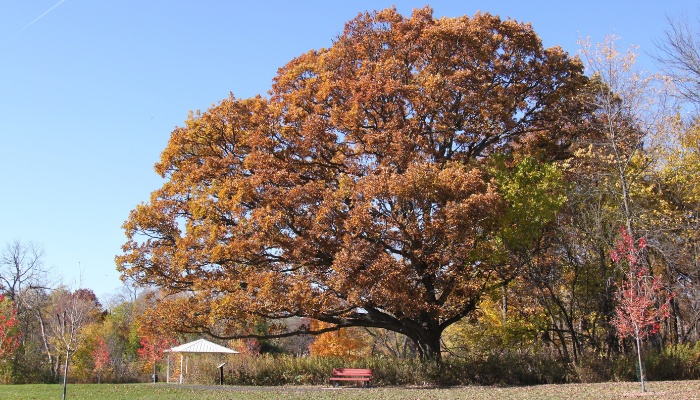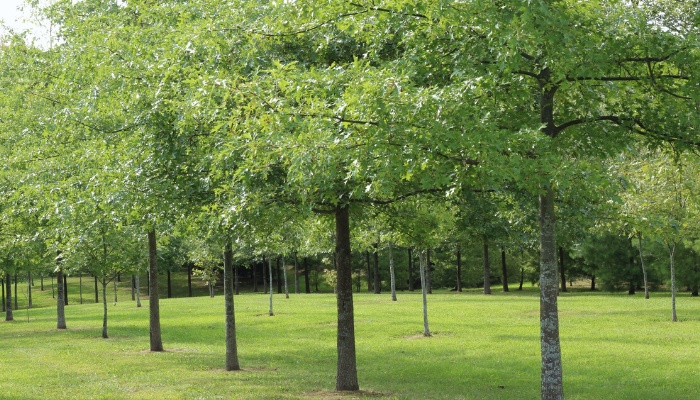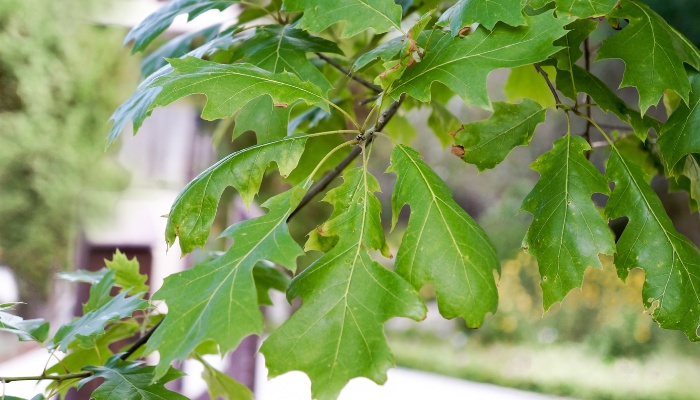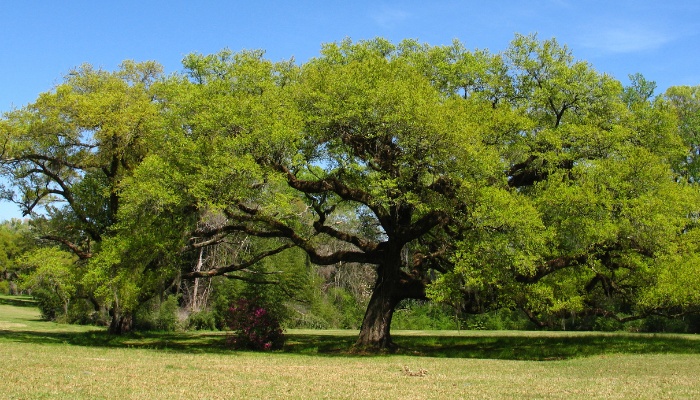Deer are naturally drawn to oak trees, as they provide not only tasty leaves and nutritious acorns, but also serve as a strong and reliable shelter in the wild.
They also offer shade, refuge, and protection from the elements. However, not all oak trees are made equally. Deer seem to favor some oak species over others.
As a food source, the following 16 oak varieties attract deer more than others. If you want to make your land a safe haven for deer or want to know where specifically to hunt, then these oaks are the ones to look for.
1. White Oak

The white oak is quite popular among many deer species including the white-tailed deer. Although the acorns can be bitter due to high levels of tannin, the deer find the young shoots too delicious to pass.
Moreover, the dried-out leaves of the white oak provide the deer with a good snack during the fall and winter.
- White Oak Leaves: 5 to 9 inches long and 3 to 4 inches wide. Seven to nine lobed. They start as red then turn yellow-green before turning dark red in the summer.
- White Oak Acorns: 1 inch long, light brown, and shiny. They’re bitter with high levels of tannin, but they’re still a valuable food source.
2. Red Oak

The acorns of red oak have high concentrations of tannin making them too bitter for deer to eat, but the young leaves and shoots have lower tannin levels, and deer will usually feed on them while leaving the mature leaves alone.
- Red Oak Leaves: 5 to 7 lobed, 10 inches long, and 5 inches wide. The tip of the leaf is toothed, but the rest is smooth. Veins dissect the leaves. The leaves start as pink and then turn deep green in the summer.
- Red Oak Acorns: 1.5 inches long and take about 18 months to ripen. They’re green and turn brown when ripe.
3. Sawtooth Oak

Native to Eastern Asia, the sawtooth oak has adapted well to North American conditions. It grows to about 90 feet on average with dark-gray bark with deep fissures.
Although it bears more acorns than other oak species, the acorns do have high tannin levels. Nonetheless, deer are drawn to the tree as a food source.
- Sawtooth Oak Leaves: 7 inches long and 2 inches wide. The edges are covered with teeth of equal size. The leaves are glossy green when they mature.
- Sawtooth Oak Acorns: 1 inch long and less than an inch wide. The base is orange and blends into green at the tip. It matures in 18 months.
4. Pin Oak

The pin oak is a medium-sized deciduous tree that grows to about 70 feet tall and 45 feet wide. The trunk is usually rough, and the canopy sometimes reaches the ground.
The acorns and mature leaves are very bitter. Deer, however, select the young shoots and leaves to feed on.
- Pin Oak Leaves: 6 inches long and 4 inches wide with 5 to 7 lobes. The lobes are covered with teeth. The top of the leaf is smooth, but the underside is covered in orange hair. In the fall, the leaves turn bronze.
- Pin Oak Acorns: About a half-inch long and grow in shallow caps. They turn brown when ripe and take 18 months to ripen.
5. Gobbler Oak

The gobbler oak is a slightly smaller version of the sawtooth oak. It grows to about 50 feet tall and has a pyramidal canopy.
The tree is quite productive and acorns develop after the sixth year. The leaves and acorns are less bitter than other oak species, and deer favor them.
- Gobbler Oak Leaves: The sawtoothed young leaves are yellow-green in the spring and yellow to brown in the fall.
- Gobbler Oak Acorns: They grow in large amounts in the fall and ripen after 18 months. Each acorn is less than half an inch long. They have low tannin levels and are a favorite of deer and other wildlife.
6. Black Oak

The black oak is a member of the red oak group that is native to North America. The tree averages 80 feet tall although it could tower over 100 feet in some regions.
- Black Oak Leaves: 4 to 8 inches long with 4 to 7 lobes. The lobes are covered with bristles. The leaves are dark green on the top and yellow-brown underneath.
- Black Oak Acorns: They grow in caps that cover almost half the acorn. They are medium in size and round.
7. Valley Oak

Valley oak is a tall oak reaching about 100 feet tall with arching branches and rippled bark.
Deer favor the leaves, shoots, and acorns of this oak since it has low levels of tannin. The leaves are aromatic and quite palatable.
- Valley Oak Leaves: 2 to 4 inches long with deep lobes. They are pale green and covered with a lot of fuzz. Broken leaves release an aromatic odor, making them the delicious food of choice for deer.
- Valley Oak Acorns: 1 inch long and brown in color. They ripen between October and November. They have a mild taste.
8. Willow Oak

The willow oak has leaves similar to willow leaves and starts producing acorns after 15 years. The tree averages between 60 and 100 feet tall and gains 2 feet per year in the right conditions.
- Willow Oak Leaves: Similar to willow leaves about 4 inches long and 1 inch wide. Smooth, bright green with a little down on the underside.
- Willow Oak Acorns: Small and grow in shallow cups. They’re almost round and average about half an inch long and wide.
9. Bur Oak

A deciduous species that grows to about 100 feet tall. It has a fast growth rate of about 20 inches a year. Both the leaves and acorns are favored by deer for their pleasant taste and moderate levels of tannin.
- Bur Oak Leaves: Broad leaves about 6 inches long and 5 inches wide. Deeply lobed but are very much edible even when they mature.
- Bur Oak Acorns: 2.5 inches long and 1 inch wide with a large cup. They’re covered with scales and ripen within 18 months. Moderate levels of tannin.
10. Blue Oak

The blue oak doesn’t attract a lot of wildlife because of its sparse foliage, but the acorns are quite tasty.
The deciduous tree grows to 60 feet tall and sometimes has multiple trunks. It has a slow growth rate of 1 foot a year.
- Blue Oak Leaves: Leathery and blue-green. About 4 inches long with no lobes.
- Blue Oak Acorns: 1 inch long with trace amounts of tannin and sweet taste. It matures within 7 months.
11. Nuttall Oak

The Nuttall oak is a fast-growing oak that reaches 80 feet at maturity. The bright-green leaves turn red in the fall.
Deer feast on the leaves no matter what color they are. In the winter, the dry leaves offer nutrition to the deer.
- Nuttall Oak Leaves: Deep lobes with sharp points. They average about 6 inches long and 5 inches wide with 5 to 7 lobes.
- Nuttall Oak Acorns: 1 inch long, oblong, with a wide cap.
12. Shumard Oak

The Shumard oak averages 80 to 110 feet tall at maturity. The trunk is gray and smooth but then ages into dark brown with deep fissures.
- Shumard Oak Leaves: 4 to 8 inches long with deep lobes. Green in the summer and red or brown in the fall.
- Shumard Oak Acorns: 1 inch in diameter and ripen within 1.5 and 3 years.
13. Swamp Chestnut Oak

The swamp chestnut oak is a very ornamental tree with leaves that turn red in the fall. It favors moist soil and grows in the wetlands mostly near creeks, river banks, and swamps.
The tree has a varying yield and bears a maximum load once every few years.
- Swamp Chestnut Oak Leaves: 4 to 11 inches long and 2 to 7 inches wide. Each leaf has between 15 and 20 small lobes.
- Swamp Chestnut Oak Acorns: 1.5 inches long and 1 inch wide. They ripen within 6 months.
14. Live Oak

The term live oak refers to a group of oak trees that are evergreen. They vary in characteristics, leaf shape, size, and acorn production widely.
- Live Oak Leaves: Vary in size, shape, and color.
- Live Oak Acorns: Vary in size, maturity, and taste.
15. Water Oak

Water oak is a member of the red oak family and is native to the United States. The tree can reach 100 feet easily with smooth bark that becomes fissured as it ages.
Although it’s a deciduous tree, the leaves tend to hang on the branches until mid-winter, giving deer a valuable food source when all other trees have shed their leaves.
- Water Oak Leaves: Shaped like a spatula and average 4 inches long and 2 inches wide. Blue-green on both sides.
- Water Oak Acorns: Half an inch long and wide with a shallow cup. They mature in the fall and take about 18 months to reach maturity.
16. Post Oak

The post oak is a small oak native to the United States that grows well in poor, dry soils. It grows to about 50 feet tall and produces acorns every two or three years once mature.
- Post Oak Leaves: Leathery, deeply lobed with sharp angles, and shaped like a Maltese cross.
- Post Oak Acorns: Three-quarters of an inch long and mature in the summer.
Closing Thoughts
Deer find more than just shade under oak trees. Some oak species are generous with their acorns and nutritious leaves while others have high levels of tannin, which render the acorns almost inedible.
